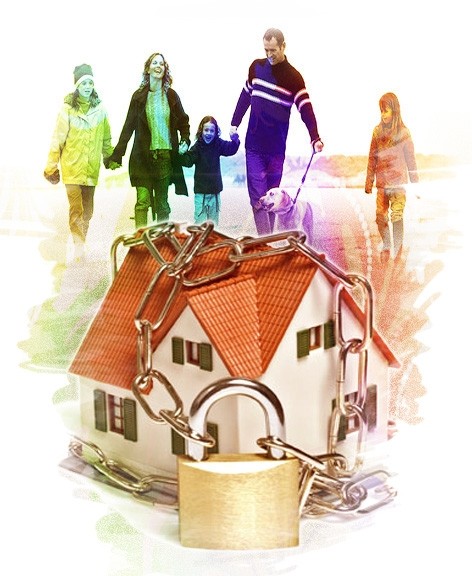Safety Topics At Home

Being safe at home means that when you arrive home, you don't become complacent about safety just because you are in a familiar place. Accidents, such as slips, falls and fires, can happen when you become unconcerned about your home surroundings. You are the best person to make your home a safe place to live.
Fire Safety
Fire safety involves knowing that you can escape your home in the event of a fire. Ideally, every room of your house should have a working smoke detector, or, if that isn't possible, have one in or outside of every bedroom. Check smoke detector batteries periodically. Keep an all-purpose fire extinguisher in your kitchen in the event of an electrical or grease fire.
Slip and Fall Prevention
It's easy to fall in your house when you can't see where you're going or if something is in your walkway that shouldn't be there. Ways to prevent falling in your home include cleaning up spills immediately after they occur; keeping your walkway free of electrical cords and other items; securing rugs with nonslip devices; and using nightlights throughout your home at night so you can see.
Safety Devices
Buying safety devices is another way to keep your home safe. Some safety devices available in stores include carbon monoxide detectors, non-scald water devices that help keep water from accidentally scalding children; ground-fault circuit interrupters that can prevent electrocution; and lid support devices that have springs to keep lids from closing on children and hurting or trapping them.
Safety Planning
Develop escape plans to be used if an emergency such as a fire happens, and practice them once a month. Everyone in the house should know where and how to exit the house in case of any emergency. Alternative escape routes should be developed as a backup plan. A meeting place outside the home should be discussed so that everyone can be accounted for.
Emergency Contact Information
Emergency contact information should be posted somewhere visible in your house, such as the refrigerator or a bulletin board. Emergency contact numbers should include 911, police department, fire department, ambulance, hospital, National Poison Control hot line, work and family members. Small children should learn their phone number and address, and how to call 911 in the event of an emergency.
Fire Safety
Fire safety involves knowing that you can escape your home in the event of a fire. Ideally, every room of your house should have a working smoke detector, or, if that isn't possible, have one in or outside of every bedroom. Check smoke detector batteries periodically. Keep an all-purpose fire extinguisher in your kitchen in the event of an electrical or grease fire.
Slip and Fall Prevention
It's easy to fall in your house when you can't see where you're going or if something is in your walkway that shouldn't be there. Ways to prevent falling in your home include cleaning up spills immediately after they occur; keeping your walkway free of electrical cords and other items; securing rugs with nonslip devices; and using nightlights throughout your home at night so you can see.
Safety Devices
Buying safety devices is another way to keep your home safe. Some safety devices available in stores include carbon monoxide detectors, non-scald water devices that help keep water from accidentally scalding children; ground-fault circuit interrupters that can prevent electrocution; and lid support devices that have springs to keep lids from closing on children and hurting or trapping them.
Safety Planning
Develop escape plans to be used if an emergency such as a fire happens, and practice them once a month. Everyone in the house should know where and how to exit the house in case of any emergency. Alternative escape routes should be developed as a backup plan. A meeting place outside the home should be discussed so that everyone can be accounted for.
Emergency Contact Information
Emergency contact information should be posted somewhere visible in your house, such as the refrigerator or a bulletin board. Emergency contact numbers should include 911, police department, fire department, ambulance, hospital, National Poison Control hot line, work and family members. Small children should learn their phone number and address, and how to call 911 in the event of an emergency.
- ye2e461ba4411e661d77480ad448291932.jpg
- 6o8ccd89858cd77326d24e5323af73be29.jpg
References
http://www.ehow.com/about_5240464_safety-topics-home.html
http://2.bp.blogspot.com/-oMKamQpduRY/Thp5CbE4NhI/AAAAAAAACIU/A0EBlU73XpA/s1600/house-safety%2Bedited.jpg
http://www.esterofire.org/kids/safety-house.jpg